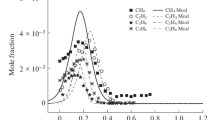Abstract
A previously proposed algorithm for constructing an optimal mechanism of the high- and low-temperature oxidation and combustion of normal paraffin hydrocarbons was used, which includes the major processes that determine the rate of reaction and the formation of the main intermediate and final products. The mechanism has the status of a nonempirical detailed mechanism, since all the constituent elementary reactions have a kinetic substantiation. The mechanism has two specific features: it included no reactions of so-called double addition of oxygen and no isomeric compounds and derivatives thereof as intermediate species. Realization of this algorithm leads to fairly compact models, a circumstance important for studies of chemical processes involving paraffin hydrocarbons C n with large n. Previously, based on this algorithm, compact mechanisms of oxidation and combustion of propane, n-butane, n-pentane, and n-hexane were constructed. In this paper, we develop a nonempirical detailed mechanism of oxidation and combustion of n-heptane. The most important feature of the new mechanism is its ability to predict the staging of the process in the form of cool and blue flames at low autoignition temperatures. A comparison of the simulation results with the available experimental data is conducted.
Similar content being viewed by others
References
C. Chevalier, P. Louessard, U. C. Muller, and J. Warnatz, in Proc. Joint Meeting of Sov. Ital. Sections Comb. Inst. (Combustion Inst., Pisa, 1990), p. 5.
F. Buda, R. Bounaceur, et al., Combust. Flame 142, 170 (2005).
A. S. Sokolik, Self-Ignition, Flame, and Detonation in Gases (Akad. Nauk SSSR, Moscow, 1960) [in Russian].
A. S. Sokolik and S. A. Yantovskii, Zh. Fiz. Khim. 20, 13 (1946).
V. Ya. Basevich and S. M. Frolov, Usp. Khim. 76, 927 (2007).
V. Ya. Basevich, V. I. Vedeneev, S. M. Frolov, and L. B. Romanovich, Khim. Fiz. 25(11), 87 (2006).
V. Ya. Basevich, A. A. Belyaev, and S. M. Frolov, Khim. Fiz. 26(7), 37 (2007) [Russ. J. Phys. Chem. B 1, 493 (2007)].
V. Ya. Basevich, A. A. Belyaev, and S. M. Frolov, Khim. Fiz. 28(8), 59 (2009) [Russ. J. Phys. Chem. B 3, 629 (2009)].
V. Ya. Basevich, A. A. Belyaev, and S. M. Frolov, Khim. Fiz. 29(7), 71 (2010) [Russ. J. Phys. Chem. B 4, 694 (2010)].
H. J. Curran, P. Gaffuri, W. J. Pitz, and C. K. Westbrook, Combust. Flame 114, 149 (1998).
M. Chaos, A. Kazakov, Z. Zhao, and F. I. Dryer, Int. J. Chem. Kinet. 39, 399 (2007).
H. Rogener, Z. Elektrochem. Angew. Phys. Chem. 53, 389 (1949).
C. F. Taylor, E. S. Taylor, J. S. Livengood, et al., SAE Quart. Trans. 4, 232 (1950).
H. Ciezki and G. Adomeit, in Proc. 16th Intern. Symp. on Shock Tubes and Waves (Niagara Falls, 1987), p. 481.
Ch. Poppe, M. Schreber, and J. F. Griffith, in Proc. Joint Meeting British and German Sections of The Combustion Institute (Cambridge, 1993), p. 1993.
H. Ciezki and G. Adomeit, Combust. Flame 93, 421 (1993).
R. Minetti, M. Carlier, M. Ribaucour, et al., Combust. Flame 102, 298 (1995).
B. M. Gauthier, D. F. Davidson, and R. K. Hanson, Combust. Flame 139, 300 (2004).
V. Ya. Basevich, V. I. Vedeneev, S. M. Frolov, and L. B. Romanovich, Khim. Fiz. 23(1), 50 (2004).
H. Machrafi and S. Cavadias, Combust. Flame 155, 557 (2008).
A. A. Belyaev and V. S. Posvyanskii, in Algorithms and Programs, Inform. Byull. Gos. Fonda Algoritmov Programm SSSR (1985), No. 3, p. 35.
M. Gerstein, O. Levin, and E. L. Wang, JACS 73, 418 (1951).
G. J. Gibbs and H. F. Calcote, J. Chem. Eng. Data 4, 226 (1959).
S. G. Davis and C. K. Law, Proc. Combust. Inst. 27, 521 (1998).
Y. Hyang, C. J. Sung, and J. A. Eng, Combust. Flame 139, 239 (2004).
S. M. Frolov, V. S. Posvyanskii, V. Ya. Basevich, et al., Khim. Fiz. 23(4), 75 (2004).
S. M. Frolov, V. Ya. Basevich, A. A. Belyaev, V. S. Posvyanskii, and V. A. Smetanyuk, in Combustion and Pollution: Environmental Impact, Ed. by G. D. Roy, S. M. Frolov, and A. M. Starik (Torus, Moscow, 2005), p. 117 [in Russian].
M. Takei, H. Kobayashi, and T. Niioka, Int. J. Micrograv. Res. Appl. Micrograv. Sci. Technol. 6(3), 184 (1993).
T. Niioka, H. Kobayashi, and D. Mito, in Proc. IVTAM Symp. on Mechanics and Combustion of Droplet and Sprays (Tainan, 1994), p. 367.
Author information
Authors and Affiliations
Corresponding author
Additional information
Original Russian Text © V.Ya. Basevich, A.A. Belyaev, V.S. Posvyanskii, S.M. Frolov, 2010, published in Khimicheskaya Fizika, 2010, Vol. 29, No. 12, pp. 40–49.
Rights and permissions
About this article
Cite this article
Basevich, V.Y., Belyaev, A.A., Posvyanskii, V.S. et al. Mechanism of the oxidation and combustion of normal paraffin hydrocarbons: Transition from C1–C6 to C7H16 . Russ. J. Phys. Chem. B 4, 985–994 (2010). https://doi.org/10.1134/S1990793110060175
Received:
Published:
Issue Date:
DOI: https://doi.org/10.1134/S1990793110060175



